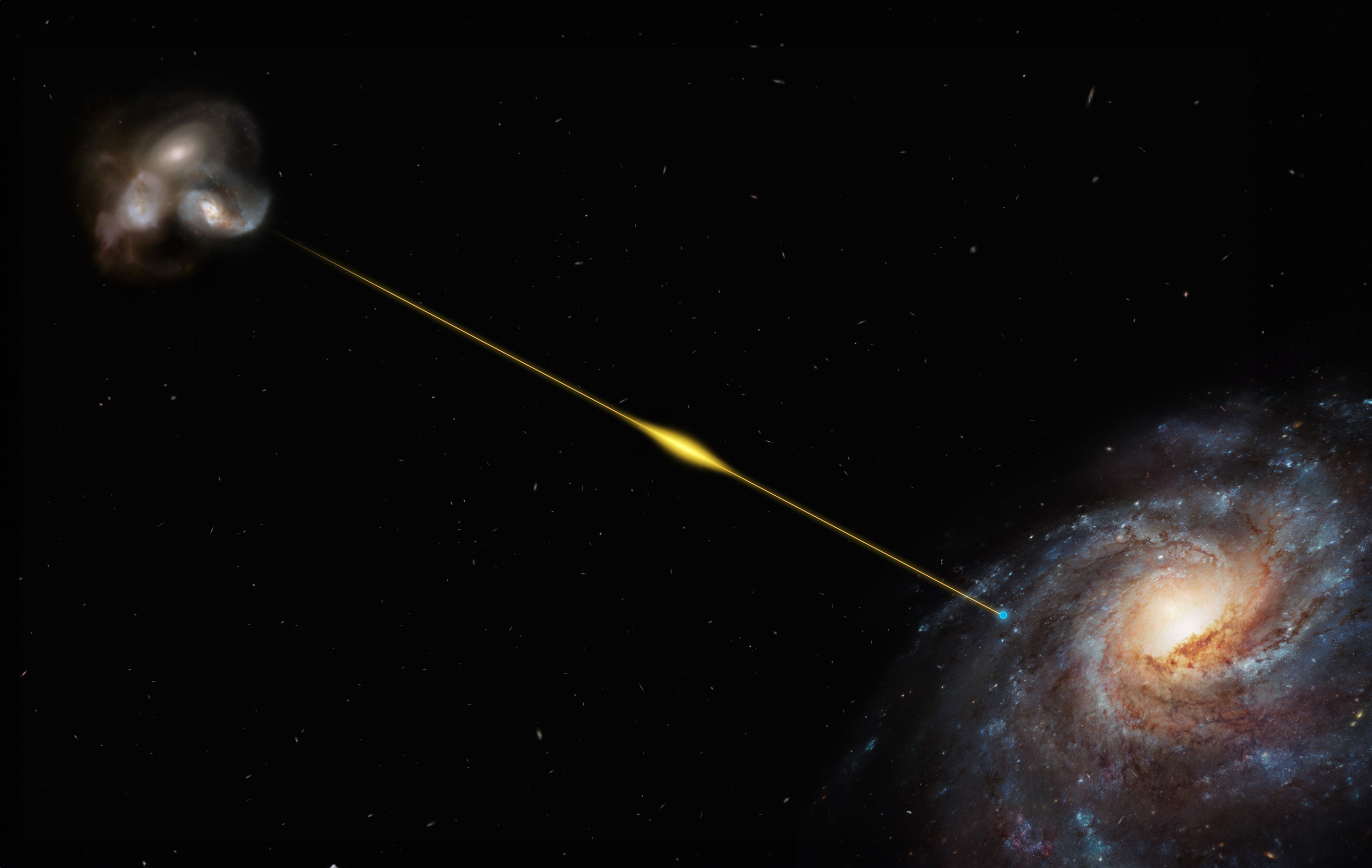Record-breaking radio burst could help us find the universe's missing matter
The 8 billion-year-old blast is the most ancient, and distant, rapid burst of radio waves ever seen originating from colliding galaxies.

An 8 billion-year-old rapid burst of radio waves, stemming from ancient colliding galaxies, could help astronomers solve the mystery of our universe’s missing matter.
The record-breaking Fast Radio Burst (FRB), which is the oldest and most distant example of its kind ever spotted, demonstrates that scientists can use these emissions to effectively "weigh" the universe.
FRBs are pulses of radio waves that often last for mere milliseconds, and are a puzzle in themselves because their origins remain a mystery. But the fact that this record-breaking example of one came from a group of two or three merging galaxies could help clear that mystery up.
The burst, designated FRB 20220610A, was spotted by the Australian Square Kilometre Array Pathfinder (ASKAP), an array of radio telescopes located in Western Australia. In just milliseconds, the FRB appeared to release as much energy as the sun puts out in 30 years.
"Using ASKAP's array of dishes, we were able to determine precisely where the burst came from," research lead author and Macquarie University researcher Stuart Ryder said in a statement. "Then we used the European Southern Observatory (ESO) Very Large Telescope (VLT) in Chile to search for the source galaxy, finding it to be older and further away than any other FRB source found to date, and likely within a small group of merging galaxies."
Related: Some mysterious ‘fast radio bursts’ may erupt from two-star systems
Where is the universe’s missing matter?
From simulating the universe, starting at the Big Bang and ending in modern times, scientists have learned that half of all matter that should be present in the universe today is effectively missing. And no, the missing matter isn't dark matter — a form of matter invisible to us due to its lack of interaction with light. It's believed to be "ordinary" matter, made up of atoms that are composed of protons and neutrons — particles called baryons.
Get the Space.com Newsletter
Breaking space news, the latest updates on rocket launches, skywatching events and more!
For decades, this missing matter has evaded detection with the largest and most sophisticated telescopes, but recently, that's been traced to a vast void of space between some galaxies. The problem, however, is this matter is so sparsely distributed that it is equivalent to no more than 2 atoms existing in a standard-sized office room here on Earth.
"If we count up the amount of normal matter in the universe — the atoms that we are all made of — we find that more than half of what should be there today is missing," team member and Swinburne University of Technology Associate Professor Ryan Shannon said. "We think that the missing matter is hiding in the space between galaxies, but it may just be so hot and diffuse that it’s impossible to see using normal techniques."
Since the early 2020s, scientists, including late Australian astronomer Jean-Pierre 'J-P' Macquart, have begun to speculate that FRBs could be used as "cosmic weight stations" to detect this nebulous matter.
"Fast radio bursts sense this ionized material,” Shannon added. "Even in space that is nearly perfectly empty, they can 'see' all the electrons, and that allows us to measure how much stuff is between the galaxies."
This is possible due to the fact that, as FRBs travel across millions or billions of light-years, their radiation is dispersed by this missing matter. That means measuring the distances to as few as six FRBs could help to determine the density of the universe — and this could ultimately help us locate its missing baryonic matter.
"J-P showed that the further away a fast radio burst is, the more diffuse gas it reveals between the galaxies," Ryder said. "This is now known as the Macquart relation. Some recent fast radio bursts appeared to break this relationship. Our measurements confirm the Macquart relation holds out to beyond half the known universe."
At the moment, around 50 FRBs have been tracked back to their sources, with the scientists behind this research suggesting that astronomers should be able to detect thousands of them across the sky, many at even greater distances.
ASKAP is responsible for pinpointing around half of the FRBs tracked back to the source thus far, and it is currently the best tool astronomers have to do this. This will soon change, however, with what will be the two largest radio telescopes in the world currently under construction in Australia and South America. When these Square Kilometre Array (SKA) telescopes come online, they should allow astronomers to track more distant and thus more ancient FRBs than even this record-breaker. Also, in the future, the Extremely Large Telescope (ELT) currently being developed in Northern Chile will be used to hone in on the source of detected FRBs.
"While we still don’t know what causes these massive bursts of energy, the paper confirms that fast radio bursts are common events in the cosmos and that we will be able to use them to detect matter between galaxies and better understand the structure of the universe," Shannon concluded.
The team’s research was published in the journal Science on Thursday, Oct. 19.
Join our Space Forums to keep talking space on the latest missions, night sky and more! And if you have a news tip, correction or comment, let us know at: community@space.com.

Robert Lea is a science journalist in the U.K. whose articles have been published in Physics World, New Scientist, Astronomy Magazine, All About Space, Newsweek and ZME Science. He also writes about science communication for Elsevier and the European Journal of Physics. Rob holds a bachelor of science degree in physics and astronomy from the U.K.’s Open University. Follow him on Twitter @sciencef1rst.









